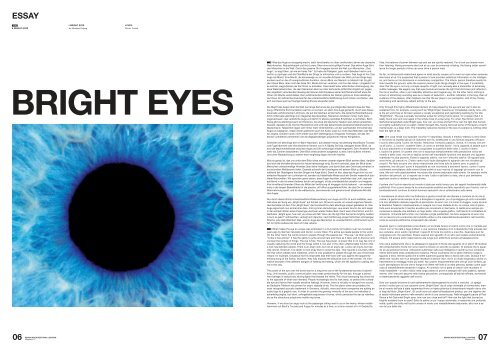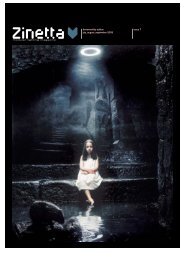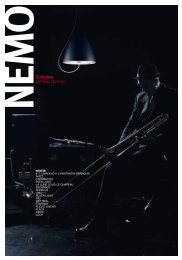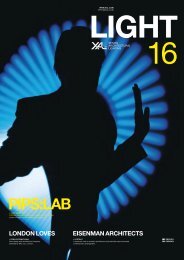ESSAYXALBRIGHT EYESBRIGHT EYESby Nikolaus ProkopPUPILPhoto: CorbisBRIGHT EYESD Was das Auge so einzigartig macht, dafür fand bereits vor über zweihundert Jahren der deutscheNaturforscher, Naturphilosoph und Arzt Lorenz Oken eine recht <strong>gr</strong>iffige Formel: Das aktive Auge führtden Menschen in die Welt. Durch das passive Ohr hingegen kommt die Welt zum Menschen. „DasAuge“, so sagt Oken „ist wie ein freies Tier“. Es habe die Fähigkeit, ganz nach Belieben hierhin unddorthin zu springen und die Oberfläche der Dinge zu erforschen und zu erobern. Das Auge ist frei. DasAuge hat Macht. Eine Macht, die keineswegs nur im visuellen Erfassen der Welt und der Dinge liegt,sondern auch in der oft uner<strong>gr</strong>ündlichen Funktion, die ein Blick von Mensch zu Mensch hat. Es gibtden bösen Blick, aber nicht das böse Ohr. Blicke können verletzen, nicht so das Hören. Umgekehrt istes leichter, wegzublicken als die Ohren zu schließen. Dies bedarf einer willentlichen Anstrengung, dieetwa Wale beherrschen, die dem Menschen aber nur über technische Hilfsmittel möglich ist: gegenden angeblich verlockenden Gesang der Sirenen ließ Odysseus seiner Schiffsmannschaft etwa dieOhren mit Wachs verschließen. Den verführerischen Anblick der Damen gönnte er ihnen allerdingsdurchaus. Ein lehrreiches Exempel für die unterschiedliche Gefährdung durch Hören und Sehen, dassich durchaus auch auf heutige Casting-Shows anwenden ließe.Die Macht des Auges über die Welt war lange Zeit eines der <strong>gr</strong>undlegenden Geheimnisse der Werbung.Öffentliche Kommunikation war bis vor kurzem vor allem fürs Auge gemacht, durch eine Dauerkanonadeverführerischer Lichtreize, die auf die Netzhaut eindonnerte. Die optische Reizüberflutungführt mittlerweile allerdings zum Gegenteil des Gewollten. Menschen tendieren immer mehr dazu,wegzuschauen, das verletzliche Auge und damit ihr ebenso sensibles Empfinden zu schützen. BeimKlang gibt es allerdings kaum ein Entrinnen, wie etwa die Deutsche Telekom seit Jahren gnadenlosbeweist: dadada-di-da. Die fünf Klaviertöne sind wohl das bekannteste akustische Markenzeichen inDeutschland. Tatsächlich legen sich immer mehr Unternehmen, um der wachsenden Immunität desAuges zu begegnen, neben einem <strong>gr</strong>afischen auch ein Audio-Logo zu: nicht etwa Melodien oder Werbe-Jingles,sondern kurze, nicht wieder aus dem Gehörgang zu kriegende Tonfolgen, die das Ohrähnlich unerbittlich penetrieren wie die allgegenwärtigen polyphonen Handy-Klingeltöne.Schenken wir allerdings dem U-Bahn-Nachbarn, aus dessen Handy minutenlang etwa Bachs Toccataund Fuge hämmert oder eine blecherne Version von In A Gadda Da Vida, besagten bösen Blick, sosind die Machtverhältnisse zwischen Auge und Ohr schleunigst wiederhergestellt. Denn Ansehen kannmehr als Zuhören beschämen. Dem Blick eines anderen ausgesetzt zu sein, kann äußerst irritieren.Und unter Beobachtung zu stehen kann langfristig sogar verrückt machen.Was es genau ist, das uns unter dem Blick eines anderen unseren eigenen Blick senken lässt, darübersind sich die Verhaltensforscher bis heute keineswegs einig. Es wird vermutet, dass der Blick einesMenschen unterschwellige Hinweise über seine Intelligenz und damit über sein Dominanzverhalten imevolutionären Wettbewerb liefert. Deshalb schweift der Unterlegene mit seinem Blick zu Boden,während der Überlegene fest den Dingen ins Auge blickt. Damit ist klar, dass das Auge nicht nur eineinfacher Rezeptor von Lichtreizen ist, sondern auf rätselhafte Weise auch ein Sender wesentlich subtilererBotschaften. Wir sprechen gerne davon, dass Augen leuchten, empfinden das Licht, das sichschillernd in der Iris eines Anderen bricht und spiegelt, oft als unwiderstehlich attraktiv und magisch.Von hinreißend tönenden Ohren als Mittel der Verführung ist hingegen nichts bekannt - ein weiteresIndiz in der langen Beweiskette für die passive, oft hilflos ausgelieferte Rolle, die das Ohr in unsererWahrnehmung spielt, und für die wählerische, dominierende und geheimnisvoll strahlende Aktivitätdes Auges.Nur durch diese höchst unterschiedliche Rollenverteilung von Auge und Ohr ist auch erklärbar, weshalbetwa ein Song wie „Bright Eyes“ auf Anhieb zum Ohrwurm wurde, ein visuell ungemein fesselndesGemälde mit dem Titel „Bright Ears“ der Kunstwelt bis dato allerdings erspart geblieben ist. DasAuge eignet sich nun einmal eher dazu, ihm Hymnen darzubringen, aus einem Grund, der sich sogarin den simpeln Zeilen eines Popsongs unschwer wieder finden lässt. Denn wenn Paul Simon und ArtGarfunkel „Bright eyes, how can you close and fail? How can the light that burned so brightly suddenlyburn so pale?“ schmachten, verbirgt sich darunter, nach Entfernung einiger Schichten schmalzigenKitschs, eine tiefe Wahrheit: Das, was im Auge des Menschen so unwiderstehlich verführerisch leuchtet,ist nichts anderes als das Licht des Lebens.E What makes the eye so unique was embodied in a truly handy formulation over two hundredyears ago by German naturalist and doctor, Lorenz Oken: The active eye leads people to the world.On the other hand, the world comes to people through the passive ear. “The eye,” as Oken puts it,“is like a free animal.” It has the ability to jump around here and there as it likes, and to discover andconquer the surface of things. The eye is free. The eye has power. A power that in no way lies only invisually capturing the world and the things within it, but also in the often unfathomable function thata look has between people. There is an an<strong>gr</strong>y look, but not an an<strong>gr</strong>y ear. Looks can injure, but hearingcannot. However, it is easier to look away than to close the ears. This requires a voluntary effort,like that which whales have mastered, which is only possible for people through the use of technicalmeans: for example, Odysseus had his shipmates seal their ears with wax against the apparentlyenticing song of the Sirens. However, they fully enjoyed the seductive look of the women. An informativeexample of the different dangers of hearing and seeing, which are still applied to casting showsto this day.The power of the eye over the world was for a long time one of the fundamental secrets of advertising.Until recently, public communication was made predominantly for the eye, through a permanentbarrage of seductively alluring lights that blasted the retina. This visual swamping has since ledto the opposite of what was intended. People increasingly tend to look away, to protect the vulnerableeye and hence their equally sensitive feelings. However, there is virtually no escape from sound,as Deutsche Telekom has proven for years: dadada-di-da. The five piano tones are probably themost recognised acoustic trademark in Germany. Actually, more and more companies are adding anaudio logo to a <strong>gr</strong>aphic one, in order to counter the <strong>gr</strong>owing immunity of the eye: not melodies oradvertising jingles, but short, unforgettable sequences of tones, which penetrate the ear as relentlesslyas the ubiquitous polyphone mobile ring tones.However, if we shoot an an<strong>gr</strong>y look at the passenger sitting next to us on the metro, whose mobilehammers out Bach’s Toccata and Fugue for minutes at a time, or a tinny version of In A Gadda DaVida, the balance of power between eye and ear are quickly restored. For a look can shame morethan listening. Having someone else look at you can be extremely irritating. And being under surveillancefor longer periods of time can even drive a person mad.So far, no behavioural researchers a<strong>gr</strong>ee on what exactly causes us to avert our eyes when someoneelse looks at us. It is suspected that a person’s look provides subliminal information on his intelligence,and hence on his dominance in evolutionary competition. The inferior person therefore averts hislook towards the <strong>gr</strong>ound, while the superior person looks things straight in the eyes. It is perfectlyclear that the eye is not only a simple receptor of light, but curiously also a transmitter of extremelysubtle messages. We eagerly say that eyes twinkle and sense the light that shimmers and reflects inthe iris of another, often in an irresistibly attractive and magical way. On the other hand, nothing isknown of attractively sounding ears as a means of seduction – another indication in the long chain ofevidence of the passive, often helpless role that the ear plays in our perception, and of the choosy,dominating and secretively radiant activity of the eye.Only through this highly differentiated division of roles played by the eye and ear can it also beexplained how, for example, a song such as “Bright Eyes” became an immediately catchy tune, whilethe art world has so far been spared a visually exceptional and captivating painting by the title“Bright Ears”. The eye is actually somewhat suited for writing hymns about, for a reason that it iseasily found over and over again in the simple lines of a pop song. For when Paul Simon and ArtGarfunkel languished under Bright eyes, how can you close and fail? How can the light that burnedso brightly suddenly burn so pale?, hidden beneath this, having removed some of the layers of sentimentalslush, is a deep truth: The irresistibly seductive twinkle of the eye of a person is nothing otherthan the light of life.I Che cosa rende così speciale l’occhio? Il naturalista, filosofo e medico tedesco Lorenz Okenci ha fornito la risposta già più di duecento anni fa, sintetizzata in una formula alquanto efficace:l’occhio attivo porta l’uomo nel mondo. Attraverso l’orecchio passivo, invece, è il mondo che arrivaall’uomo. „L’occhio“, sostiene Oken „è come un animale libero“. Ha la capacità di saltare qua elà a suo piacimento e di esplorare e conquistare la superficie delle cose. L’occhio è libero.L’occhio ha potere. Un potere che non si esaurisce semplicemente nella percezione visiva delmondo e delle cose, ma che si esplica anche nell’insondabile funzione che assume uno sguardoscambiato tra due persone. Esiste lo sguardo cattivo, ma non l’orecchio cattivo. Gli sguardi possonoferire, gli orecchi no. D’altro canto è più facile distogliere lo sguardo che non chiudere gliorecchi. Per farlo occorre uno sforzo intenzionale che forse solo le balene sono in <strong>gr</strong>ado disostenere, ma che per l’uomo è impossibile se non ricorrendo a strumenti tecnici: contro il cantoinutilmente ammaliatore delle sirene Ulisse ordinò ai suoi marinai di tappargli gli orecchi con lacera. Ma non volle assolutamente rinunciare alla visione seducente delle sirene. Un esempio moltoistruttivo dei pericoli, cui ci espone da un lato l’udito e dall’altro la vista, che si può benissimoapplicare anche ai moderni casting shows.Il potere che l’occhio esercita sul mondo è stato per molto tempo uno dei se<strong>gr</strong>eti fondamentali dellapubblicità. Fino a poco tempo fa la comunicazione pubblica era fatto soprattutto per l’occhio, con unbombardamento continuo di stimoli luminosi seducenti che si schiantavano sulla retina.L’inondazione di stimoli ottici nel frattempo è giunta a livelli tali da ottenere il contrario di ciò che sivoleva. La gente tende sempre di più a distogliere lo sguardo, pur di proteggere gli occhi vulnerabilie la loro altrettanto delicata capacità di percezione. Ai suoni non c’è modo di sfuggire, come da annila Deutsche Telekom impietosamente ci insegna con il suo dadada-di-da. Le cinque note di pianofortesono sicuramente il marchio acustico più conosciuto in Germania. In realtà sono sempre piùnumerose le aziende che adottano un logo audio, oltre a quello <strong>gr</strong>afico, nell’intento di contrastare lacrescente immunità dell’occhio: non melodie o jingle pubblicitari, ma brevi sequenze di suoni chenon si riescono più a scacciare dal condotto uditivo e che inesorabilmente penetrano nell’orecchiocome le suonerie polifoniche onnipresenti dei cellulari.Quando però in metropolitana scocchiamo un’occhiata feroce al nostro vicino che ci martella perminuti con la Toccata e fuga di Bach o una versione metallica di In A Gadda Da Vida emessa dalsuo cellulare, ecco subito ripristinati i rapporti di forza tra occhio e orecchio. Guardare può farvergognare più che ascoltare. Essere esposti allo sguardo di un altro può essere estremamenteirritante. Ed essere sotto osservazione alla lunga può addirittura portare all’esasperazione.Che cos’è esattamente che ci fa abbassare lo sguardo di fronte allo sguardo di un altro? Gli studiosidel comportamento finora non sono riusciti a trovare un accordo su questo. Si ipotizza che lo sguardodi una persona fornisca indicazioni subliminari sulla sua intelligenza e quindi sul suo comportamentodominante nella competizione evolutiva. Perciò la persona che si sente inferiore rivolge losguardo a terra, mentre quella che si sente superiore guarda fisso in faccia alle cose. Dunque è evidenteche l’occhio non è un semplice recettore di stimoli visivi, ma in un modo enigmatico anche untrasmettitore di messaggi molto più sottili. Noi usiamo frequentemente dire che gli occhi brillano, gliocchi percepiscono la luce che si frange e si riflette nell’iride di un’altra persona, spesso come qualcosadi irresistibilmente attraente e magico. Al contrario non si parla di orecchi che risuonano inmodo estasiante – un altro indizio nella lunga catena di prove a sostegno del ruolo passivo, spessoinerme, che l’orecchio assume nella nostra percezione, contrapposto all’attività raffinata, dominantee misteriosamente raggiante dell’occhio.Solo con questa divisione di ruoli estremamente disomogenea fra occhio e orecchio , si spiegaanche il motivo per cui una canzone come „Bright Eyes“ sia di colpo diventata un tormentone, mentreal mondo dell’arte è stata risparmiata finora un’opera pittorica di straordinario impatto visivo chesi fregi del titolo „Bright Ears“. Gli occhi sono più adatti all’esaltazione poetica, per una ragione chesi lascia individuare persino nelle semplici strofe di una canzone pop. Nelle struggenti parole di PaulSimon e Art Garfunkel Bright eyes, how can you close and fail? How can the light that burned sobrightly suddenly burn so pale? Sotto la patina un po’ troppo sdolcinata, si nasconde una profondaverità: quello che brilla nell’occhio umano in modo così irresistibilmente seducente, altro non è senon la luce della vita.<strong>XENON</strong> <strong>ARCHITECTURAL</strong> <strong>LIGHTING</strong><strong>XENON</strong> <strong>ARCHITECTURAL</strong> <strong>LIGHTING</strong>06 <strong>Magazine</strong> <strong>12</strong><strong>Magazine</strong> <strong>12</strong> 07
PORTRAITXALPLAJER & FRANZ STUDIO, BERLINMoods in SpaceArchitects: plajer & franz studio, BerlinAuthor: Nikolaus ProkopPhoto: diephotodesigner.dewww.plajer-franz.deMOODSIN SPACED Visitkarten können langweilige Papierstückchen sein. Oder auch aufregende Räume. Orte, dieman beim ersten Mal überrascht betritt – und danach mit jener schönen Regelmäßigkeit besucht wiejene Handvoll echter Freunde, bei denen man auch um zwei Uhr morgens noch unangemeldet aufkreuzenkann. Einen dieser raren Orte haben Alexander Plajer und Werner Franz vor einigen Jahren mittenan einer der pulsierendsten Lebensadern Berlins geschaffen: am unteren Kurfürstendamm, im Gebäudeder Schaubühne am Lehniner Platz, die bis vor einiger Zeit zusehends in angestaubter Hochkultur-Langeweiledahinzudümpeln drohte.Heute präsentiert sich das Haus – ein Baujuwel der Neuen Sachlichkeit, in den zwanziger Jahren vonErich Mendelsohn, einem der profiliertesten Vertreter der deutschen Moderne errichtet – deutlich verjüngt,und die neue Bar, die plajer & franz studio dem Theater in den Räumen des ehemaligen Universum-Kinoshinzugesellten, wurde auf Anhieb von der Lifestyle-Fibel wallpaper unter die besten Bars derWelt gekürt. Denn mit ihrer Universum Lounge, die vor vier Jahren als eine der angesagtesten Tränken ineiner nicht gerade armen Stadt ihre Pforten öffnete, haben plajer & franz studio nicht nur einfach eine Bargebaut, sondern mit obsessiver Detailverliebtheit eine Stil-Ära rekonstruiert und neu interpretiert, wie siederart konsequent kaum je real existiert hat: der Sixties-Chic der gekurvten Teakholz-Flächen, der goldfarbenenStruktur-Paneele und der gerippten Lederbänke in cleanem Raumanzug-Weiß orientiert sichkeineswegs an den spießigen Real-Sechzigern der Post-Adenauer-Ära, sondern vor allem an den futuristischen,mondänen Filmsets, wie sie Ken Adam (übrigens ironischer Weise selbst aus Berlin stammend)für Stanley Kubricks Dr. Strangelove kreierte oder für James-Bond-Abenteuer wie Thunderball oder YouOnly Live Twice. Als wäre sie sich ihrer Funktion als Set für den Lebensfilm einer jungen, stilbewusstenKlientel urbaner Besserverdiener durchaus bewusst, liefert die Universum Lounge selbst kleine ironischeHinweise auf ihre hyperauthentische Nicht-Authentizität. So zeigt etwa die Digitaluhr an der Wand dieOrtszeit von Houston, und alte, hinterleuchtete Cibacrome-Raumfahrtfotos an den Wänden machen klar,welcher Film hier gespielt wird – die erste Mondlandung, die die cocktailtrinkenden Baby-Boomer an derTheke damals als Fünfjährige auf dem teakholzverkleideten Schwarzweißfernseher sahen.„Wir sind gut im Schaffen von Atmosphären“, resümiert Werner Franz, „deshalb ist eine Bar ein garnicht so schlechter Anknüpfungspunkt, um über unsere Arbeit zu reden. Denn in einer Bar geht es inerster Linie ums Wohlfühlen – um die Atmosphäre eben.“ Ihr besonderes Gespür für Raumstimmungenkonnten die beiden Gründer von plajer & franz studio bereits früh und auf höchstem internationalemLevel schulen: nach ihrer Studienzeit in München verschlug es die beiden Jugendfreunde auf verschiedenen,einander immer wieder kreuzenden Umwegen zunächst nach New York, wo Alexander Plajerzunächst bei Richard Meier und Werner Franz bei Tsao & McKown arbeitete. Mitte der neunziger Jahretraf man mehr oder weniger zufällig („Wo soll man nach New York schließlich schon hingehen?“, soAlexander Plajer) wieder in Berlin aufeinander, wo sich das internationale Know-How der beiden in deraufkeimenden Wirtschaftsdynamik nach dem Mauerfall schnell bezahlt machte. Vor allem über deneuropaweiten Rollout von Store-Projekten für das Outdoor-Fashionlabel Timberland wuchs aus demZwei-Mann-Büro in einem Kreuzberger Loft innerhalb weniger Jahre eines der führenden Interiordesign-StudiosEuropas, das sich vor allem mit Store- und Retail-Projekten für BMW (u.a. der Gestaltungder BMW-Messestände auf der IAA und dem Genfer Autosalon, der BMW-Designstudios und der BMWLifestyle-Stores), S.Oliver oder Samsung weit über Deutschland hinaus einen Namen machte. „Wirhaben unsere Struktur schön langsam und gesichert ausgebaut, heute können wir uns über mangelndenErfolg wirklich nicht beklagen“, freuen sich die beiden. „Zusätzlich hatten wir das Glück, zu Beginnviel zu viel Fläche in unserem 1000-Quadratmeter-Loft zu haben – und selbst jetzt, zehn Jahre späterund mit demnächst rund vierzig Mitarbeitern, ist unsere Raumsituation immer noch sehr entspannt.“Entspannt blickt man bei plajer & franz studio auch der weiteren Expansion in den kommenden Jahrenentgegen, vor allem auch in den Zukunftsmärkten. Aktuelle Projekte wie z.B. Hotel-Ressorts in Kroatien,Portugal und Thailand, Luxus-Apartments in Lissabon oder auch kreative Ausflüge wie kürzlich dasDesign einer Yacht beweisen, wie universell anwendbar das Know-How von plajer & franz studio alshochkarätige Retail-Spezialisten ist: „Wir sind gern in mehreren Bereichen und möglichst interdisziplinärtätig“, definieren Alexander Plajer und Werner Franz ihre erfol<strong>gr</strong>eiche Strategie, „so können wir ausjedem unserer Projekte Wissen beziehen, das wiederum in andere Projekte einfließt. Was man z.B. imbeleuchtungstechnisch sehr anspruchsvollen Retail-Bereich lernt, resultiert in extrem wertvollen Kompetenzenfür nahezu alle anderen Interiordesign-Bereiche. Hinzu kommt beispielsweise auch, dass sichaus unserer Innenarchitektur-Kompetenz nun vermehrt auch neue Hochbau-Projekte ergeben, oderdass wir gerade dabei sind, eine Grafik- und Kommunikationsdesign-Abteilung für die wachsendenAufgaben im Branding- und CI-Bereich für Store- und Messeprojekte aufzubauen – die zukünftigenSynergien sind also ziemlich spannend.“E Visitor cards can be boring bits of paper. Or even exciting spaces. Places that one first enters with<strong>gr</strong>eat surprise – and subsequently visits with such lovely regularity, as one does a handful of true friendsthat can be disturbed without prior announcement at two o’clock in the morning. Alexander Plajerand Werner Franz created one of these rare places a few years ago along one of the most pulsatingarteries of Berlin: on the lower Kurfürstendamm, in the building of the theatre on Lehniner Platz, whichuntil recently seemed to be threatening to collapse into dusty high-culture boredom.Today, the building – a jewel of the New Objectivity movement, erected in the 1920s by Erich Mendelsohn,a high-profile representative of the German modern movement – has been significantly rejuvenated,and the new bar, which plajer & franz studio added to the spaces of the former Universum cinema,was immediately nominated one of the best bars in the world by lifestyle bible wallpaper. For with theirUniversum Lounge, which opened its doors four years ago as one of the most popular watering placesin a far from poor city, plajer & franz studio have not only just built a bar, but have reconstructed andreinterpreted an era in style with an obsessive passion for detail, which in reality hardly ever actuallyexisted: the Sixties chic of curved teakwood surfaces, the gold-coloured structural panels and the ribbedleather benches in clean spacesuit white are in no way orientated towards the bourgeois real Sixtiesof the post-Adenauer era, but above all towards the futuristic, fashionable film sets as designed byKen Adam (himself ironically originally from Berlin) for Stanley Kubrick’s Dr. Strangelove, or for JamesBond adventures such as Thunderball or You Only Live Twice. As if fully aware of its function as the setfor the bio<strong>gr</strong>aphical film of a young, style-conscious clientele of urban high-earners, the UniversumLounge gives small ironic pointers to its hyperauthentic non-authenticity. For example, the digital clockon the wall shows the local time in Houston, and old, backlit Cibacrome photo<strong>gr</strong>aphs of space travel onthe wall make it clear which film is being screened here – the first lunar landing that the cocktail-drinkingbaby boomers at the bar once watched as five-year olds on the teakwood panelled black-andwhitetelevision set.“We are good at creating atmospheres,” summarises Werner Franz, “which is why a bar is a <strong>gr</strong>eatplace to talk about our work. After all, a bar is primarily about feeling good – it’s about the atmosphe-re.” The two founders of plajer & franz studio trained their particular feeling for spatial moods early onand at the highest international level: having studied in Munich, the two childhood friends constantlycrossed each other’s paths, amongst other places in New York. where Alexander Plajer first workedat Richard Meier and Werner Franz at Tsao & McKown. In the mid-90s, they met each other againmore or less by chance in Berlin (“Where do you actually go after New York?” says Alexander Plajer),where their international expertise quickly paid off in the germinal economic dynamism that followedthe fall of the Berlin Wall. Above all, the European rollout of store projects for outdoor fashion labelTimberland caused the two-man office based in a loft in Kreuzberg to <strong>gr</strong>ow in just a few years intoone of the leading interior design studios in Europe, which made a name for itself across Germanyand beyond, especially with store and retail projects for BMW (among other projects the design ofthe BMW trade show booths at the IAA and at the Geneva Salon, of the BMW design studios and ofthe BMW lifestyle stores), S.Oliver and Samsung. “We have expanded our organisation slowly andcarefully, and really cannot complain about a lack of success today,” the two men say happily. “Wealso had the good fortune initially of having far too much space in our 1000 square metre loft – andeven now, ten years later and with around forty employees, we still have a very relaxed situationwhere space is concerned.”The view of future expansion in the coming years is also relaxed at player & franz, especially in up-andcomingmarkets. Current projects such as hotel resorts in Croatia, Portugal and Thailand, luxury apartmentsin Lisbon or creative excursions such as the upcoming design of a yacht prove how universallyapplicable the expertise of plajer & franz studio is as top quality retail specialists: “We enjoy working inseveral areas, and as interdisciplinary as possible,” Alexander Plajer and Werner Franz define their successfulstrategy, “which lets us draw knowledge from every project, which in turn flows into other projects.For example, what is learnt in the very demanding retail area in terms of lighting technologyresults in extremely valuable competences for virtually all other areas of interior design. It is also thecase, for example, that our interior architecture competence is increasingly generating new buildingprojects, or that we are currently in the process of building up a <strong>gr</strong>aphics and communication designdepartment for the <strong>gr</strong>owing tasks in branding and CI area for store and trade fair projects – the synergiesof the future are therefore quite exciting.”I I biglietti da visita possono essere dei pezzetti di carta noiosi. Oppure spazi eccitanti. Luoghi, dovela prima volta si entra per farsi sorprendere e poi si visitano con piacevole regolarità, come ogni <strong>gr</strong>uppodi veri amici che si possono incontrare, anche senza preavviso, alle due del mattino. Da alcuni anniAlexander Plajer e Werner Franz hanno creato uno di questi luoghi rari al centro di una delle arterie piùvitali di Berlino: nella Kurfürstendamm di sotto, nell’edificio del teatro di Lehniner Platz, che fino a pocotempo fa incombeva dall’alto della sua noiosa e polverosa cultura.Oggi l’edificio – un gioiello edilizio del Neorealismo degli anni Venti di Erich Mendelsohn, uno dei principalirappresentanti del Moderno tedesco – si presenta ringiovanito, e il nuovo bar, che plajer & franzstudio hanno voluto inserire nei locali dell’ex sala cinemato<strong>gr</strong>afica Universum, è stato citato tra i miglioribar del mondo su suggerimento dell’abc del lifestyle, la rivista wallpaper. Con la sua UniversumLounge, che quattro anni fa ha aperto le porte all’elité del buon bere di una città non esattamentepovera, plajer & franz studio non hanno costruito solo un semplice bar, ma hanno ricostruito e reinterpretatocon un’attenzione ossessiva ai dettagli un’era stilistica, come non è mai realmente esistita: lochic degli anni Sessanta che si ritrova nelle superfici incurvate in legno teak, nei pannelli strutturalidorati e nei banconi nervati rivestiti in pelle e inseriti in un ambiente vestito di bianco, non riflette il realismopiccolo-borghese degli anni Sessanta dell’era Post-Adenauer, ma piuttosto vuole riprodurresoprattutto i set cinemato<strong>gr</strong>afici mondani e futuristici, come quelli creati da Ken Adam (che ironicamenteha origini berlinesi) per il Dottor Stranamore di Stanley Kubrick, o per le avventure di JamesBond in Thunderball o You Only Live Twice. Come se fosse consapevole di essere il set del film dellavita di una clientela metropolitana, giovane e di stile, la Universum Lounge suscita lievi richiami ironicialla propria non-autenticità iperautentica. Ecco che l’orologio digitale sulla parete indica l’ora di Houstone vecchie foto<strong>gr</strong>afie spaziali retroilluminate in cibacrome appese alle pareti illustrano di quale filmsi tratta – il primo allunaggio, che i Baby Boomer, che stanno sorseggiando ora i loro cocktail al banco,ammiravano allora, quando avevano solo cinque anni, dallo schermo in bianco e nero delle lorotelevisioni rivestite di teak."Siamo bravi a creare atmosfere", ripete Werner Franz, "per questo un bar non è poi un punto di incontrocosì malvagio per parlare del nostro lavoro. Perché in un bar si cerca soprattutto di stare bene e divivere anche un’atmosfera". I due fondatori dello plajer & franz studio hanno saputo insegnare la loroparticolare sensibilità per l’armonia nello spazio già in precedenza, e al massimo livello internazionale:dopo gli studi a Monaco, i due giovani sono stati risucchiati da strade diverse, ma che si sono sempreincontrate di nuovo e più volte, subito verso New York - dove Alexander Plajer ha lavorato prima conRichard Meier e Werner Franz alla Tsao & McKown. A metà degli anni Novanta, si sono incontrati dinuovo, più o meno per caso, a Berlino ("Dove deve andare uno dopo New York?" come sostiene AlexanderPlajer), dove il know-how internazionale dei due si è fatto apprezzare all’interno della dirompentee dinamica economia del dopo-muro. Nel giro di pochi anni, soprattutto <strong>gr</strong>azie al rollout europeo di progettidi store per l’etichetta della moda outdoor Timberland, dall'ufficio dei due uomini in un loft aKreuzberg è nato uno degli studi di interior design leader a livello europeo; lo studio si è fatto un nomeed ha valicato i confini della Germania, <strong>gr</strong>azie principalmente a progetti di store e retail per BMW (traaltri progetti il disegno delle cabine di esposizione commerciale del BMW allo IAA ed al Salone de Ginevra,degli studi di disegno del BMW e dei depositi di lifestyle del BMW), S. Oliver o Samsung. “Abbiamocostruito la nostra struttura lentamente, ma con sicurezza, ed oggi non possiamo certo lamentarci dinon avere successo", si ralle<strong>gr</strong>ano i due. "Abbiamo avuto anche la fortuna di avere all’inizio fin troppospazio nel nostro loft da 1000 metri quadrati – ed ancora oggi, dieci anni più tardi e con quasi quarantacollaboratori, i nostri spazi ci offrono ancora molta libertà".Da plajer & franz studio si respira liberamente anche l’espansione dei prossimi anni, soprattutto neimercati del futuro. I progetti di oggi, come ad esempio gli Hotel Resort in Croazia, Portogallo e Tailandia,gli appartamenti di lusso a Lisbona, ma anche voli creativi come il design di uno yacht, testimonianol’universalità del know-how di plajer & franz studio come specialisti di alta caratura del retail: "Cioccupiamo volentieri di diversi settori nel modo più interdisciplinare possibile", così definiscono AlexanderPlajer e Werner Franz il loro successo strategico, "così possiamo estrapolare da ciascun progettoconoscenze da utilizzare anche in altri progetti. Quello che si impara, ad esempio, dall’affascinante settoredell’illuminotecnica per il retail produce competenze di estremo valore anche per quasi tutti gli altrisettori dell’interior design. E in più, dalle nostre competenze per l'architettura di interni si generano emoltiplicano anche nuovi progetti di edilizia, oppure visto che ne stiamo parlando, si crea un reparto di<strong>gr</strong>afica e design per la comunicazione nell’ambito dell’impegno sempre crescente nei settori branding eCI per progetti di store e fiere – le sinergie future sono quindi parecchio energizzanti".08<strong>XENON</strong><strong>ARCHITECTURAL</strong> <strong>LIGHTING</strong><strong>Magazine</strong> <strong>12</strong><strong>XENON</strong> <strong>ARCHITECTURAL</strong> <strong>LIGHTING</strong><strong>Magazine</strong> <strong>12</strong>09







![Lataa tästä Building06 nettikirje [PDF] [591.72 KB] - Teclux](https://img.yumpu.com/41499677/1/184x260/lataa-tasta-building06-nettikirje-pdf-59172-kb-teclux.jpg?quality=85)








